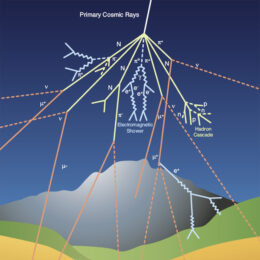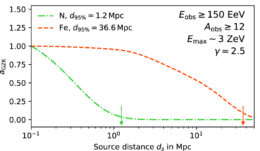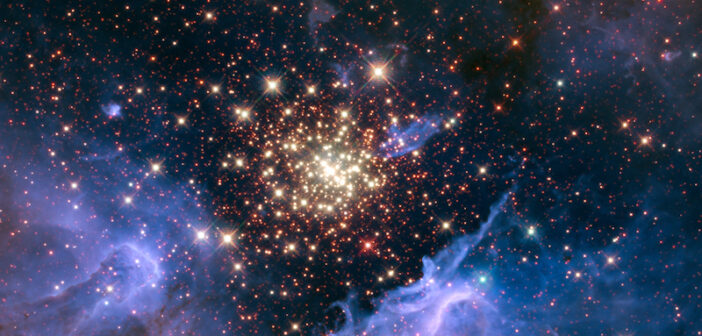Researchers have explored the best places to search for ultra-high-energy cosmic rays: charged particles that can travel at nearly the speed of light. New cosmic ray “treasure maps” bring us one step closer to tracking down the origins of these rare particles.
Cosmic Particle Accelerators

A diagram illustrating the shower of particles created when a cosmic ray enters Earth’s atmosphere. Click to enlarge. [CERN]
Where in the universe cosmic rays reach their extreme speeds is still up for debate, though supernovae, accreting supermassive black holes, highly magnetized stellar remnants called magnetars, and gamma-ray bursts are all possible sites of cosmic-ray acceleration. Complicating the hunt for these sites is the fact that after cosmic rays are shot into space, they’re buffeted and misdirected by a tangled web of magnetic fields. As a result, where we see a cosmic ray come from might not be where it actually came from.

The loss-of-number density, aGZK, as a function of the distance of the cosmic-ray source, shown for nitrogen nuclei (dot-dashed green line) and iron nuclei (dashed orange line) with energies greater than 150 exaelectronvolts. The source distance at which 95% of particles fail to reach Earth is marked for each species with an arrow. In this simulation, the detector is sensitive to particles with masses greater than 12 atomic mass units. [Adapted from Globus et al. 2023]
Looking for Paired Particles
In a recent research article, a team led by Noémie Globus (University of California, Santa Cruz, and the Institute of Physical and Chemical Research, Japan) suggested that we may be able to identify the sites of cosmic-ray acceleration by detecting two cosmic rays from the same source arriving from the same direction at the same time. Magnetic fields between the cosmic-ray source and Earth make this kind of coordination unlikely. Globus and collaborators proposed that these paired particles might arrive more often from some parts of the sky than others.
The team focused on cosmic rays with energies in excess of 150 exaelectronvolts, about two of which are caught by our cosmic ray detectors each year. In addition to considering how magnetic fields affect the passage of these particles, the team also considered which cosmic rays are most likely to survive the journey to Earth. As cosmic rays zip through space, they interact with photons from the cosmic microwave background that suffuses the universe. This interaction strips protons and neutrons away from the cosmic ray, reducing its mass and energy. This means that the distance a cosmic ray can travel before being disassembled — and therefore, the distance of the cosmic-ray sources we can detect — depends on its initial mass and energy.
Treasure Maps for Rare Cosmic Rays

An example treasure map for a nitrogen nucleus with an energy of 150 exaelectronvolts. The projection is centered on the galactic anticenter (GA), while the galactic center (GC) appears at the right and left sides. [Adapted from Globus et al. 2023]
In addition to suggesting where to look, the team notes that their work can be used to guide how to look. Because a cosmic ray’s mass determines how far it can travel before being destroyed, building detectors that can measure the mass of cosmic rays reaching Earth can help us pinpoint where the particles originated.
Citation
“Treasure Maps for Detections of Extreme Energy Cosmic Rays,” Noémie Globus et al 2023 ApJ 945 12. doi:10.3847/1538-4357/acaf5f

